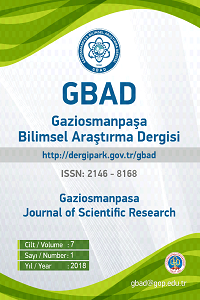Bilgisayar Ağı Güvenliği için Hibrit Öznitelik Azaltma ile Makine Öğrenmesine Dayalı Bir Saldırı Tespit Sistemi Tasarımı
Atak tespiti, Makine öğrenimi, Ağ güvenliği, Öznitelik azaltma
Designing a Machine Learning Based Intrusion Detection System with Hybrid Feature Reduction for Network Security
___
- Aldweesh, A., Derhab, A., & Emam, A. Z. (2020). Deep learning approaches for anomaly-based intrusion detection systems: A survey, taxonomy, and open issues. Knowledge-Based Systems.
- Breiman, L. (2001). Random Forests. Machine learning, s. 5-32.
- Cahyo, A. N., Sari, A. K., & Riasetiawan, M. (2020). Comparison of Hybrid Intrusion Detection System. In 2020 12th International Conference on Information Technology and Electrical Engineering, s. 92-97.
- Choudharya, S., & Kesswani, N. (2020). Analysis of KDD-Cup’99, NSL-KDD and UNSW-NB15 Datasets using Deep Learning in IoT. Procedia Computer Science, s. 1561-1573.
- Chumerin, N., & Hulle, M. M. (2006). Comparison of Two Feature Extraction Methods Based on Maximization of Mutual Information. In 2006 16th IEEE signal processing society workshop on machine learning for signal processing, s. 343-348.
- Cisco. (2019). Cisco Visual Networking Index: Forecast and Trends, 2017–2022 White Paper. www.cisco.com: https://www.cisco.com/c/en/us/solutions/collateral/service-provider/visual-networkingindex-vni/complete-white-paper-c11-481360.html adresinden alındı
- Fujita, H., Gaeta, A., Loia, V., & Orciuoli, F. (2019, 5). Resilience Analysis of Critical Infrastructures: A Cognitive Approach Based on Granular Computing. IEEE Transactions on Cybernetics, s. 1835-1848.
- Gurung, S., Ghose, M. K., & Subedi, A. (2019). Deep Learning Approach on Network Intrusion Detection System using NSL-KDD Dataset. International Journal of Computer Network and Information Security, s. 8-14.
- Halimaa, A. A., & Sundarakantham, K. (2019). Machine Learning Based Intrusion Detection System. In 2019 3rd International conference on trends in electronics and informatics (ICOEI), s. 916-920. HINTON, G. E., & SALAKHUTDINOV, R. R. (2006). Reducing the Dimensionality of Data with Neural Networks. science, s. 504-507.
- Hubballia, N., & Suryanarayanan, V. (2014). False alarm minimization techniques in signature-based intrusion detection systems. A survey. Computer Communications, s. 1-17.
- Jyothsna, V., & Vaddella, R. P. (2011). A Review of Anomaly based IntrusionDetection Systems. International Journal of Computer Applications, s. 26-35.
- Liao, H.-J., Lin, C.-H. R., Lin, Y.-C., & Tung, K.-Y. (2013). Intrusion detection system: A comprehensive review. Journal of Network and Computer Applications, s. 16-24.
- Liu, J., Kantarci, B., & Adams, C. (2020). Machine learning-driven intrusion detection for Contiki-NG-based IoT networks exposed to NSL-KDD dataset. In Proceedings of the 2nd ACM workshop on wireless security and machine learning, s. 25-30.
- Miao, J., & Niu, L. (2016). A Survey on Feature Selection. Procedia Computer Science, s. 919-926.
- Pedregosa, F., Varoquaux, G., Gramfort, A., Michel, V., Thirion, B., Grise, O., . . . Duchesnay , E. (2011). Scikit-learn: Machine Learning in Python. the Journal of machine Learning research, s. 2825-2830.
- Scarfone, K., & Mell, P. (2007). Guide to intrusion detection and prevention systems. NIST special publicatio, s. 94. Subba, B., Biswas, S., & Karmakar, S. (2016). Enhancing performance of anomaly based intrusion detection systems through dimensionality reduction using principal component. In 2016 IEEE International Conference on Advanced Networks and Telecommunications Systems (ANTS), s. 1-6.
- Taher, K. A., Jisan, B. M., & Rahman, M. (2019). Network Intrusion Detection using Supervised Machine Learning Technique with Feature Selection. In 2019 International conference on robotics, electrical and signal processing techniques, s. 643-646.
- Tavallaee, M., Bagheri, E., Lu, W., & Ghorbani, A. A. (2009). A detailed analysis of the KDD CUP 99 data set. In 2009 IEEE symposium on computational intelligence for security and defense applications, s. 1-6.
- Tavallaee, M., Stakhanova, N., & Ghorbani, A. A. (2010). Toward Credible Evaluation of Anomaly-Based Intrusion-Detection Methods. IEEE Transactions on Systems, Man, and Cybernetics, s. 516-524.
- Vapnik, V. N. (1999). The nature of statistical learning theory. Springer science & business media.
- Wu, K., Chen, Z., & Li, W. (2018). A Novel Intrusion Detection Model for a Massive Network Using Convolutional Neural Networks. Ieee Access, s. 50850-50859.
- Yan, Y., Qi, L., Wang, J., Lin, Y., & Chen, L. (2020). A Network Intrusion Detection Method Based on Stacked Autoencoder and LSTM. In ICC 2020-2020 IEEE International Conference on Communications (ICC), s. 1-6.
- Zamani, M., & Movahedi, M. (2013). Machine learning techniques for intrusion detection. arXiv preprint arXiv:1312.2177.
- Zhang, C., Ruan, F., Yin, L., Chen, X., Zhai, L., & Liu, F. (2019). A Deep Learning Approach for Network Intrusion Detection Based on NSL-KDD Dataset. In 2019 IEEE 13th International Conference on Anti-counterfeiting, Security, and Identification, s. 41-45.
- Zulfiker, M. S., Kabir, N., Biswas, A. A., Nazneen, T., & Uddin, M. S. (2021). An in-depth analysis of machine learning approaches to predict depression. Current research in behavioral sciences.
- ISSN: 2146-8168
- Yayın Aralığı: Yılda 3 Sayı
- Başlangıç: 2012
- Yayıncı: Tokat Gaziosmanpaşa Üniversitesi
Çilekte Ana Bitki ve Yavru Bitkiler Arasındaki Su İletişiminde Stolonun Rolü
İstatistiksel Yöntemler Uygulanarak Tokat İl Merkezinin Heyelan Duyarlılık Haritalarının Üretilmesi
Mehmet GÜNEŞ, Gülçin Eda BABADAĞ
Insecticidal and Antimicrobial Effects of Pseudomonas Species Isolated From Waste Water
Sürdürülebilir Ulaşım Sistemi Kapsamında Bisiklet Yollarının Değerlendirilmesi: Diyarbakır Örneği
Üniversite Öğrencilerinin Fast-Food Tüketim Alışkanlıklarının İncelenmesi
Sivas İli Mantar Tüketim Alışkanlığının Belirlenmesi
Türkiye Karayollarında Ölümlü-Yaralanmalı Trafik Kazalarına Neden Olan Sürücü Kusurlarının Analizi
